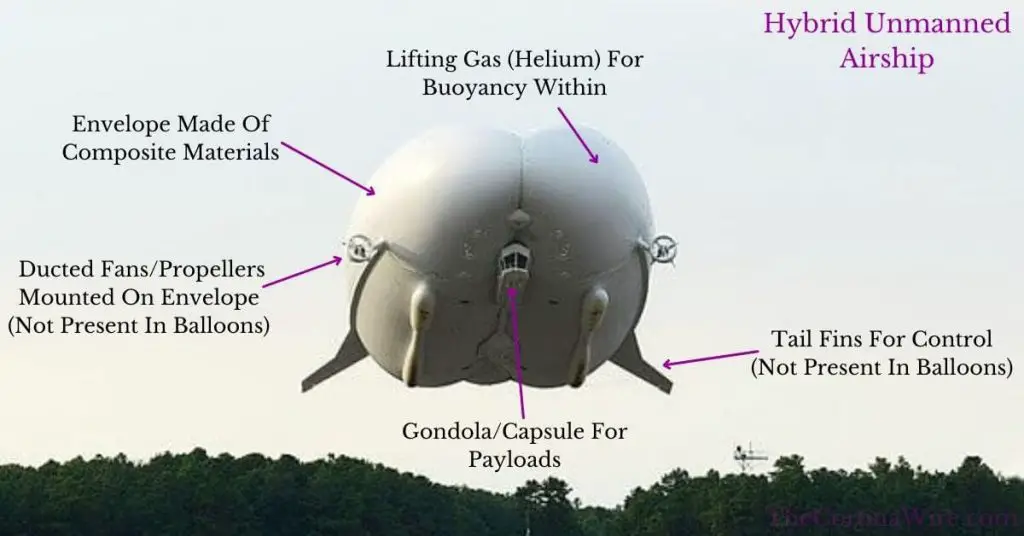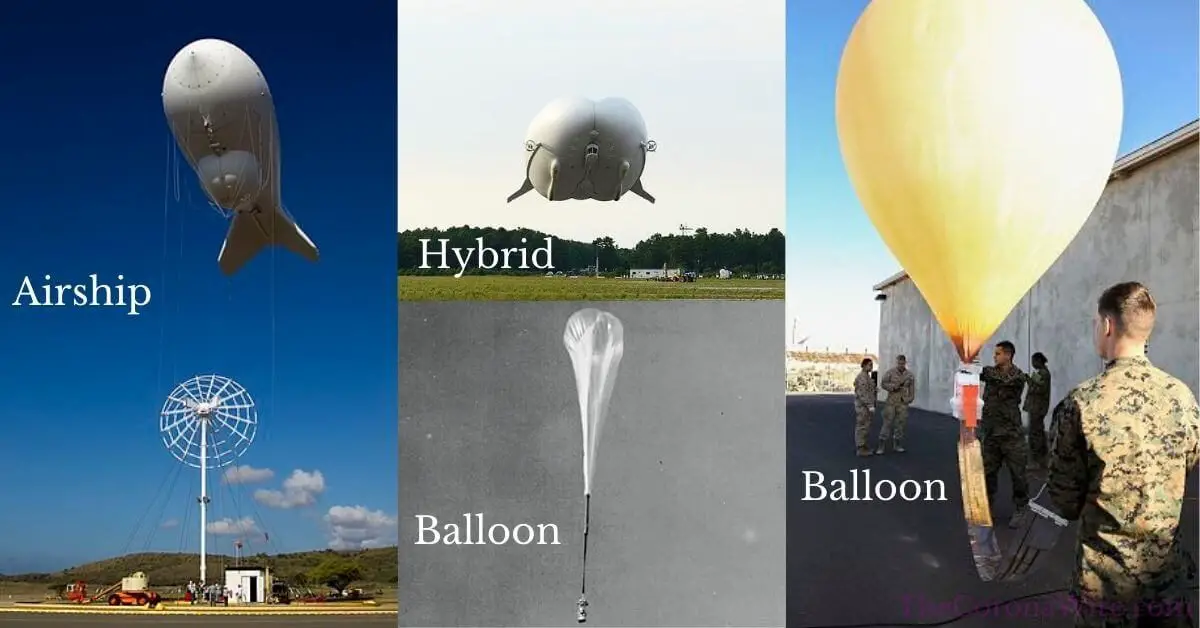Unmanned aerostats were some of the earliest drones ever used alongside fixed-wing UAVs. These types of unmanned robots have been on the rise in recent years as individuals and large institutions begin to understand their potential.
What are unmanned aerostats?
Unmanned aerostats are floating drones/unmanned aerial vehicles (UAVs) that fly using lifting gas to obtain buoyancy. Some can be steered and others cannot.
These types of drones are considered to be lighter-than-air aircraft.
Take note that aerostats include both balloons and airships. They are not specific to balloons.
- How Do Unmanned Aerostats Work?
- What Are The Types Of Unmanned Aerostats?
- What Are Unmanned Aerostats Used For?
- What Parts/Components Make Up Unmanned Aerostats?
- What Are The Advantages & Disadvantages Of Unmanned Aerostats?
- Unmanned Aerostat Power Sources/Propulsion Devices
- What Are Some Examples Of Unmanned Aerostats?
- Conclusion
How Do Unmanned Aerostats Work?
Unmanned aerostats use lifting gas (typically helium) contained within an envelope to obtain buoyancy and float in the air.
Buoyancy is a force typically found in fluids where an object of a certain weight will either rise, float, or sink depending on whether it is less dense (rises), equal in density (floats), or denser (sinks) than the fluid it’s in.
The pressure exerted in the object will typically increase the deeper it sinks.

Unmanned aerostats will typically not inflate their envelopes (or gasbags in the case of rigid airships) fully as the higher they go, the lower the pressure outside gets which will cause the lighter-than-air gas within to expand.
Once the pressure within the envelope is equal to the pressure in the surrounding air, they will have reached the pressure height. Flying higher than this will increase the risk that the envelope/gasbags rupture as the materials used to contain lifting gas are only so strong.
Most aerostats use helium as it’s non-flammable, effective and safe, and sometimes also hot air. In the past, they used hydrogen which is far more dangerous as it’s flammable.
In the case of an unmanned airship, the shape of their main envelopes can be maintained using internal pressure (non-rigid/blimps), can be maintained using both internal pressure and a supporting structure (semi-rigid), or can be maintained using an outer structural framework (rigid).
Unmanned airships are powered using various power sources such as batteries, fuel cells, solar energy, and are also directly powered using powered tethers and propulsion devices such as propellers.
Check out our full post where we dive into several power sources and propulsion devices currently used in drones. For each power source, we expand on how they work, the different types, the advantages, disadvantages, and real-world examples of drones that use it.
Related Post: How Are Drones Powered? 6 Drone Energy Sources Explained
Power is either supplied via a ground/mobile control station through a powered tether or is found on-board the aircraft itself.
They can be steered using control devices found on the tail assembly of the aircraft which typically includes tail fins that can act as rudders.
In the case of unmanned balloons, these envelopes are often non-rigid, relying on the internal pressure from the lifting gas within them to stay aloft. They can however also have a supporting structure to aid in maintaining the shape of the envelope.
Tethered unmanned aerostats have a grounded anchor point that they attach to in order to stay in a fixed location in the air.
Both unmanned airships and unmanned balloons often have ground/mobile control stations where the operators can receive and measure data gathered from the aerostat. This data can be sent wirelessly using radio waves or through a powered tether.
The size of the main envelope will impact the maximum flight time, range, and altitude the aerostat can achieve.
No aerostat can fly forever as the lifting gas stored within the main envelope will continuously leak. They need to be refuelled with helium for extended use.
What Are The Types Of Unmanned Aerostats?
There are two ways to categorise unmanned aerostats. The first is to separate them into powered and unpowered aerostats, and the second is the primary way to categorise them.
Here are the two types of unmanned aerostats:
- Unmanned airships
- Unmanned balloons
Unmanned airships are types of powered aerostat drones/UAVs that propel themselves through the air while having full control over the aircraft and float using lifting gas for buoyancy.
Check out our full post on unmanned airships where we dive into how they work, their types, applications, parts/components, advantages/disadvantages, propulsion systems and examples:
Related Post: What Are Unmanned Airships? Aerostat Drones/UAVs Explained
There are several types of unmanned airships including non-rigid airships (Unmanned blimps), semi-rigid airships, and rigid airships.
There are also some hybrid unmanned airships that obtain some lift from lifting gas and some from aerodynamic lift like a conventional aeroplane.
Unmanned balloons are types of unpowered aerostat drones/UAVs that are either free-floating using surrounding wind as propulsion or tethered to an anchor point. Both float using lifting gas for buoyancy.
Check out our full post on unmanned balloon aerostats where we dive into how they work, their types, applications, parts/components, advantages/disadvantages and examples:
Related Post: What Are Unmanned Balloons? Aerostat Drones/UAVs Explained
What Are Unmanned Aerostats Used For?
Here are 5 applications for unmanned aerostats:
- Exploring the atmospheres of other planets
- Measuring weather patterns
- High-altitude ISR
- Long distance cargo delivery
- Extending the reach/capacity of communications systems
Check out our full post on aerostat drone applications where we explain what each use case entails and how unmanned aerostats are used in them:
Related Post: 6 Awesome Unmanned Aerostat Drone Applications Explained
What Parts/Components Make Up Unmanned Aerostats?
We’ve split the parts & components of aerostats into two sections based on the two primary types of aerostats just for those parts & components that are unique to each type.
Unmanned airships are made of an envelope, gondola/capsule, tail assembly/empennage, propulsion system, communications system, payload, and sometimes a tether.
The main envelope is a sack made of fabric that contains the lifting gas enabling an unmanned aerostat to fly.
A gondola/capsule is a compartment typically suspended beneath the main envelope of both unmanned airships and balloons that carry payloads.
Check out our post where we dive into what drone tethers are, the different types, uses, advantages/disadvantages, materials they’re made of, costs, examples and more:
Related Post: Drone Tethers Explained: What They Are & How They Work
The tail assembly/empennage is typically made of tail fins which can act as rudders to control the drone’s yaw and tailplanes/horizontal stabilisers to control the drone’s pitch.
The propulsion system includes power sources such as batteries, fuel cells and solar cells. Propulsion devices within the system are typically propellers used by unmanned airships for propulsion.
These propulsion devices can be placed in various positions on the UAV including the tail assembly, the gondola/capsule, and attached directly to the envelope.
The communications system is the system enabling an unmanned aerostat to send and receive data to and from the operators. This data can be the information gathered by payloads or the inputs made by the operators to steer the drone (unique to unmanned airships).
Payloads include any additional weight an unmanned aerostat can carry that is not essential for it to function other than its base weight. This includes sensors and freight.
Semi-rigid airships also have a stiff keel or truss in order to maintain the shape of the envelope along with the internal pressure generated by the gas within the envelope.
Rigid airships have several gasbags/cells containing lifting gas within the envelope.
Unmanned balloons are made of an envelop, basket/gondola/capsule, communications system, payload, and often a tether.
Tethered unmanned aerostats are going to need both tethers of certain lengths and an anchor point. These tethers can either be powered or unpowered.
Powered tethers are commonly referred to as ‘live’ tether systems whereas unpowered tethers are commonly referred to as ‘dead’ tether systems.
The anchor point can also be a ground/mobile control station enabling operators on the ground to monitor and measure data taken from the payloads found on the UAV.
All unmanned aerostats can carry various payloads of various weights including but not limited to electro-optical/infrared (EO/IR) sensors, freight and barometers (measures atmospheric pressure) among many others.
These payloads are often attached underneath the main envelope using cables for both unmanned airships and balloons.
All unmanned aerostats are typically required to have lights and radar reflectors and follow certain rules that vary by country in order to legally operate and prevent mid-air collisions with other aircraft.
What Are The Advantages & Disadvantages Of Unmanned Aerostats?
The aerostat configuration is a very old design used in both manned and unmanned systems. These types of UAVs have many benefits but are not without drawbacks as is the case with all aircraft.
We’ve split up the advantages and disadvantages into their own separate sections.
Unmanned aerostat advantages
Here are 5 advantages of unmanned aerostats:
- They typically have very high payload capacities
- They can fly for very long periods of time
- Unmanned balloons are cheaper to operate compared to other types of UAVs
- They can be made to be very durable capable of widthstanding rough weather conditions
- They are typically very stable
Unmanned aerostat disadvantages
Here are 5 disadvantages of unmanned aerostats:
- They are very slow
- The helium used for lifting gas is expensive
- Tethered aerostats have a limited operating range
- They have to be grounded/anchored in order to provide a resupply of helium in order to extend its operating time
- Typically, the larger the aerostat, the more operators and maintenance workers will be required
Unmanned Aerostat Power Sources/Propulsion Devices
Here are 5 power sources/propulsion devices used in unmanned aerostats:
- Batteries
- Solar Cells
- Fuel Cells (FCs)
- Propellers
- Motors
What Are Some Examples Of Unmanned Aerostats?
Here are 11 examples of unmanned aerostats:
| Name | Manufacturer | Type |
| GA22 | BAE Systems | Unmanned Airship (Non-Rigid/Blimp) |
| Skystar 180 | Aeronautics Defense Systems | Unmanned Balloon (Tethered) |
| DATT SA-70 | UAV Corp+Skyborne Technology | Unmanned Airship (Semi-Rigid) |
| WASP (Winch Aerostat Small Platform) Aerostat | Drone Aviation Corp | Unmanned Balloon (Tethered) |
| Persistent Threat Detection System (PTDS) 74K | Lockheed Martin | Unmanned Airship (Non-Rigid/Blimps) |
| Thunderhead Balloon Systems | Raven Aerostar | Unmanned Balloon (Free-Floating) |
| Corsair | Euro Airship | Unmanned Airship (Rigid) |
| Tethered Aerostat Radar System (TARS) 420k | Lockheed Martin | Unmanned Airship (Non-Rigid/Blimps) |
| High Altitude Airship (HAA) | Lockheed Martin | Unmanned Airship (Non-Rigid/Blimp) |
| Airlander 10 | Hybrid Air Vehicles | Hybrid Unmanned Airships |
| Skystar 300 | Aeronautics Defense Systems | Unmanned Balloon (Tethered) |
If you’d like to discover who the best drone companies are in the world for the consumer, commercial and military drone markets and some fun facts about them, we have a full post on this topic below:
Related Post: Top Drone Companies/Manufacturers In The World [History, What They Offer, Popular Drones And More]
Conclusion
Unmanned aerostats prove very useful for several operations and are becoming more and more popular. These types of aircraft may soon become commonplace within the unmanned systems industry.
